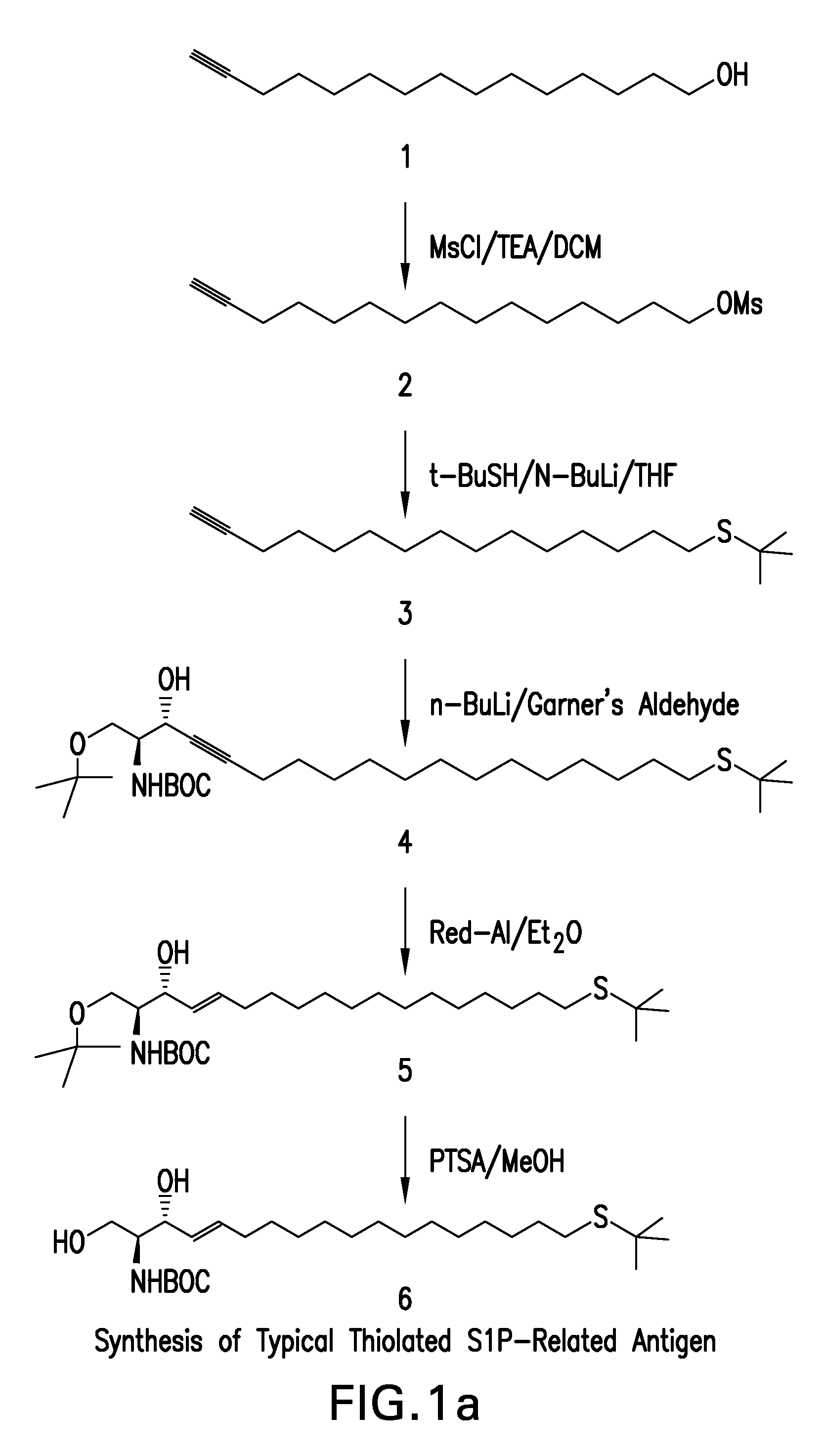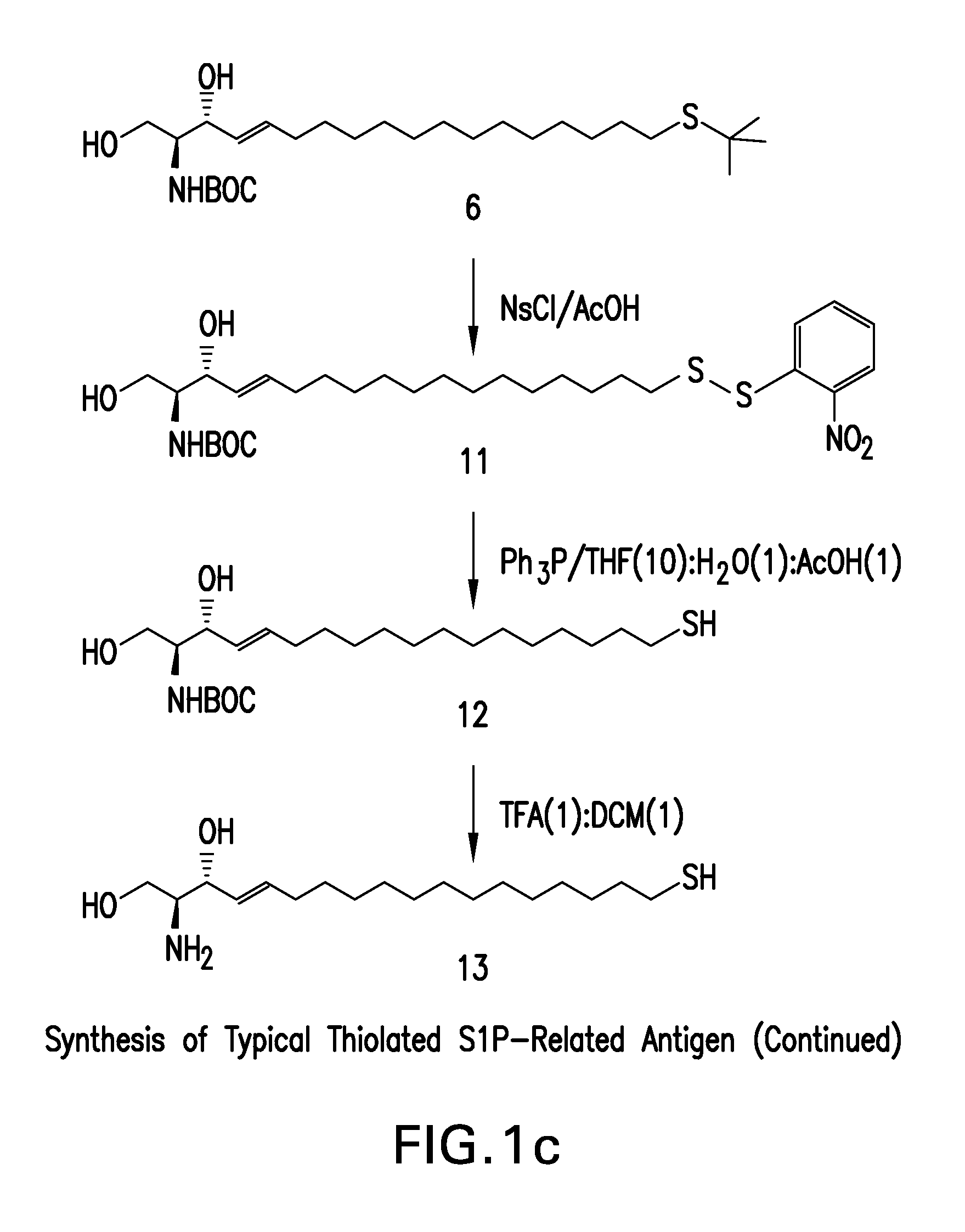Compositions and Methods for Binding Lysophosphatidic Acid
a lysophosphatidic acid and lysophosphatidic acid technology, applied in the field of agents, can solve the problems of affecting the effect of lpa1 receptor gene activity, so as to reduce the effective concentration of lpa and reduce aberrant hyperproliferation
- Summary
- Abstract
- Description
- Claims
- Application Information
AI Technical Summary
Benefits of technology
Problems solved by technology
Method used
Image
Examples
example 1
Synthetic Scheme for Making a Representative Thiolated Analog of S1P
[0367]The synthetic approach described in this example results in the preparation of an antigen by serial addition of structural elements using primarily conventional organic chemistry. A scheme for the approach described in this example is provided in FIG. 1, and the compound numbers in the synthetic description below refer to the numbered structures in FIG. 1.
[0368]This synthetic approach began with the commercially available 15-hydroxyl pentadecyne, 1, and activation by methyl sulphonyl chloride of the 15-hydroxy group to facilitate hydroxyl substitution to produce the sulphonate, 2. Substitution of the sulphonate with t-butyl thiol yielded the protected thioether, 3, which was condensed with Garner's aldehyde to produce 4. Gentle reduction of the alkyne moiety to an alkene (5), followed by acid catalyzed opening of the oxazolidene ring yielded S-protected and N-protected thiol substituted sphingosine, 6. During ...
example 2
Synthetic Schemes for Making Thiolated Fatty Acids
[0388]The synthetic approach described in this example details the preparation of a thiolated fatty acid to be incorporated into a more complex lipid structure that could be further complexed to a protein or other carrier and administered to an animal to elicit an immune response. The approach uses using conventional organic chemistry. A scheme showing the approach taken in this example is provided in FIG. 2, and the compound numbers in the synthetic description below refer to the numbered structures in FIG. 2.
[0389]Two syntheses are described. The first synthesis, for a C-12 thiolated fatty acid, starts with the commercially available 12-dodecanoic acid, compound 14. The bromine is then displaced with t-butyl thiol to yield the protected C-12 thiolated fatty acid, compound 15. The second synthesis, for a C-18 thiolated fatty acid, starts with the commercially available 9-bromo-nonanol (compound 16). The hydroxyl group in compound 16...
example 3
Synthetic Scheme for Making a Thiolated Analog of LPA
[0399]The synthetic approach described in this example results in the preparation of thiolated LPA. The LPA analog can then be further complexed to a carrier, for example, a protein carrier, which can then be administered to an animal to elicit an immugenic response to LPA. This approach uses both organic chemistry and enzymatic reactions, the synthetic scheme for which is provided in FIG. 3. The compound numbers in the synthetic description below refer to the numbered structures in FIG. 3.
[0400]The starting materials were compound 15 in Example 2 and enantiomerically pure glycerophoshocholine (compound 22). These two chemicals combined to yield the di-acetylated product, compound 23, using DCC to facilitate the esterification. In one synthetic process variant, the resulting di-acylated glycerophosphocholine was treated first with phospholipase-A2 to remove the fatty acid at the sn-2 position of the glycerol backbone to produce co...
PUM
| Property | Measurement | Unit |
|---|---|---|
| molecular weight | aaaaa | aaaaa |
| length | aaaaa | aaaaa |
| pH | aaaaa | aaaaa |
Abstract
Description
Claims
Application Information
 Login to View More
Login to View More - R&D
- Intellectual Property
- Life Sciences
- Materials
- Tech Scout
- Unparalleled Data Quality
- Higher Quality Content
- 60% Fewer Hallucinations
Browse by: Latest US Patents, China's latest patents, Technical Efficacy Thesaurus, Application Domain, Technology Topic, Popular Technical Reports.
© 2025 PatSnap. All rights reserved.Legal|Privacy policy|Modern Slavery Act Transparency Statement|Sitemap|About US| Contact US: help@patsnap.com



